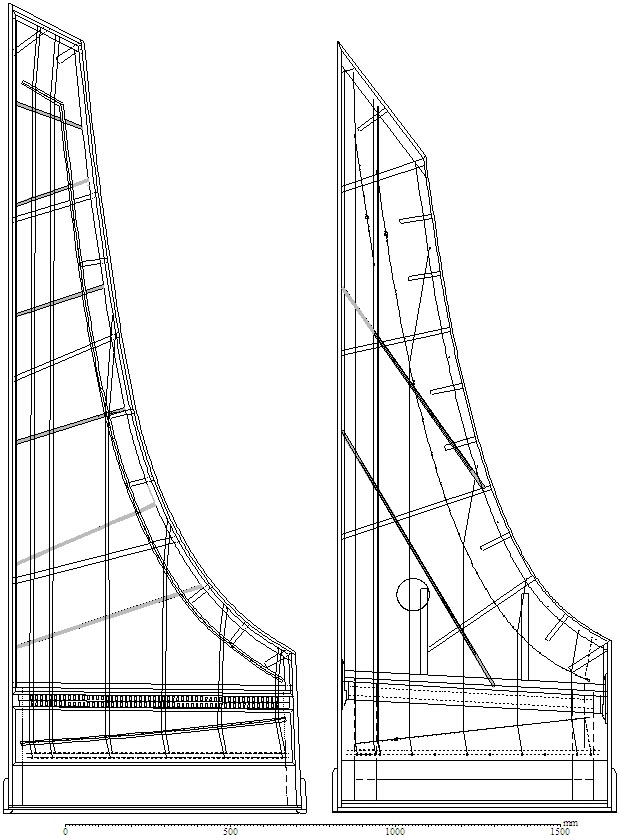

The above plan-view drawings show the harpsichord by Francesco Fabbri (Rome, c.1630) now in the collection of the Accademia Pianistica (an image of the instrument can be seen in the middle on the right-hand side in this link) on the left and the cassa falsa levatoia Neapolitan harpsichord designed here. There are several differences that are immediately noticeable:
The Fabbri harpsichord, although it goes down to G1 in the bass, is only slightly longer than the Neapolitan harpsichord which goes down only to C. This is because the Neapolitan harpsichord has Pythagorean scalings throughout the whole of its compass. Even using red brass strings in the bass this requires much longer bass string lengths than in the bass of the Fabbri where the scalings are considerably foreshortened.
The plucking points in the bass of the Fabbri harpsichord are somewhat closer to the nut than in the Neapolitan harpsichord. In the treble the Fabbri plucks the string close to the centre of the string and therefore there is more contrast between the treble and bass sound quality than in the Neapolitan harpsichord which is more uniform in its plucking ratios and therefore in its sound quality.
All of the soundboard barring in the Fabbri harpsichord runs underneath the bridge and is mostly at an angle of about 90º to the bridge. In the Neapolitan harpsichord there is a single heavy bar running roughly parallel to the bridge in the alto part of the compass and a thin bar running very obliquely to the bridge in the tenor compass. The soundboard in the Fabbri harpsichord is considerably stiffened by the combination of the transverse barring and the fact that the cutouts in the barring underneath the bridges sometimes actually miss the bridge position leaving the bridge standing above the solid part of the soundbar. The soundboard of the Neapolitan harpsichord with oblique barring is much more flexible because the main bar is well away from the bridge and because the light bass bar, with a wide cut-out in it underneath the bridge, lies almost parallel to the soundboard grain direction so that the whole flexes easily across the grain of the soundboard.
Perhaps the most striking difference between the two instruments, however, is the difference in the distances from the bentside to the bridge. In the Fabbri the bridge is very close to the bentside liner (~58mm) increasing greatly the general stiffness of the barring/soundboard system. In the Neapolitan harpsichord on the other hand, the bridge lies much further from the bentside liner (~131mm) resulting in much more flexibility in the bridge and soundboard.
The Fabbri's sound is characterised by a weak, thin sound with a noticeable contrast between the treble and bass tonal quality. The sound of the Neapolitan harpsichord by contrast is strong, rich and even across the whole of the compass. The latter are, indeed, qualities that characterise most of the instruments made in Naples. In my opinion this is the main reason that Cristofori and Ferrini spent much of their time re-working these well-designed and well-constructed instruments.